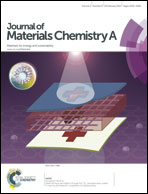The composite electrode of LiFePO4 cathode materials modified with exfoliated graphene from expanded graphite for high power Li-ion batteries†
Abstract
In recent years, copious papers have reported the fruitful modifications of LiFePO4-based composites and exhibited excellent electrochemical performance in terms of rate capability and cycling stability. Besides, the optimization of bulk electrodes are essential to keep pace with composites, by enhancement of the electronic and ionic transport to further improve the power performance of an electrode. Therefore, in this work, a facile strategy is adopted to fabricate a composite electrode with NMP as a solvent, containing large-size multilayer graphene, which is prepared by the exfoliation of economical expanded graphite under high power ultrasound in isopropyl alcohol. Active LiFePO4 nanograins, as well as conductive additives, are attached to the superior conductive graphene and thereby fast pathways are established as a “highway” for electronic transport in the bulk electrode. As a result, this composite electrode exhibits a lower polarization at high-rate charge–discharge processes. The operating flat voltage of 20 C rate is maintained at more than 3.0 V in one minute and its discharge capacity is up to 107.8 mA h g−1, representing a better energy density and power density.


 Please wait while we load your content...
Please wait while we load your content...